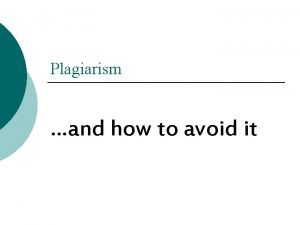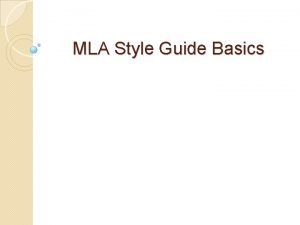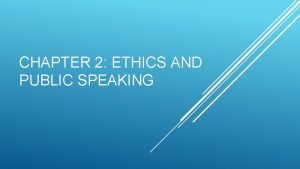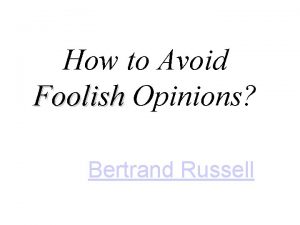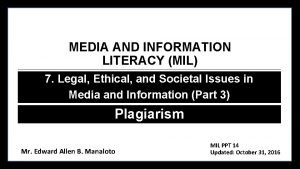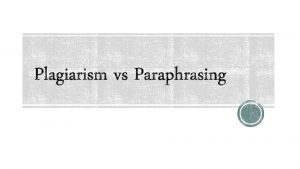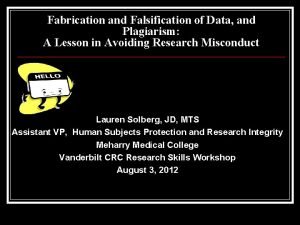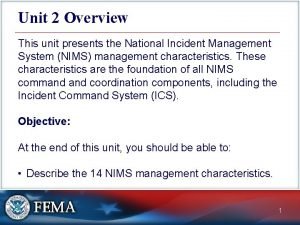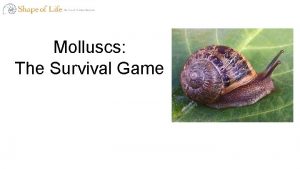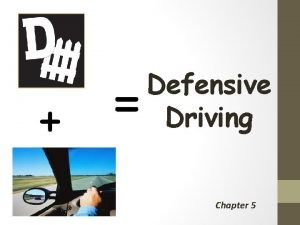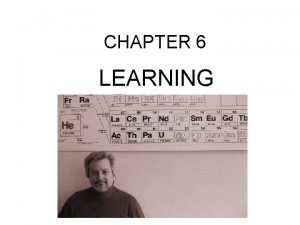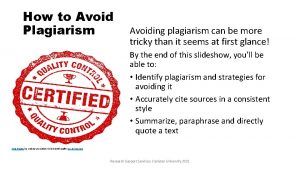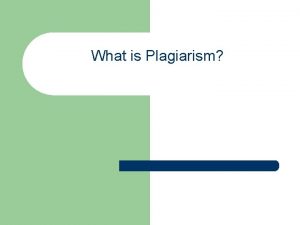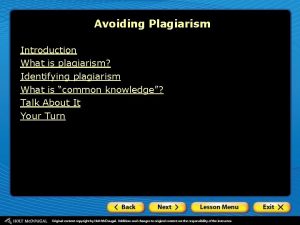Plagiarism what it is and how to avoid






















- Slides: 22

Plagiarism what it is and how to avoid it ADAPTED FROM PRESENTATION BY MEGAN LOWE, ULM REFERENCE LIBRARIAN

Session Overview What It Is ◦ Terminology ◦ Legal Implications ◦ Four Types of Plagiarism How to Avoid It ◦ Methods ◦ Proper Quotations ◦ Proper Citations Q&A

Terminology: Plagiarism is the act of stealing someone else's work and attempting to "pass it off" as your own. This can apply to anything, from term papers to photographs to songs, even ideas!

Implications Because of copyright, plagiarism is often against the law. Most schools and universities have policies on cheating and plagiarism. Joy’s Policy(see syllabus) is very clear: ◦ First offense: zero on assignment & must see professor ◦ Second offense: failing grade for the course ◦ Depending on seriousness of offense, could be expelled from DSU

Types of Plagiarism: Copying The most well-known and, sadly, the most common type of plagiarism is the simplest: copying. If you copy someone else's work and put your name on it, you have plagiarized.

Copying: An Example

Copying: An Example This one is pretty straightforward. If a writer copies, word for word, the text from another’s work and does not acknowledge in any way to whom the credit should be given, the writer has committed plagiarism.

Types: Patchwork Plagiarism The second kind of plagiarism is similar to copying and is perhaps the second most common type of plagiarism: patchwork plagiarism. This occurs when the plagiarizer borrows the "phrases and clauses from the original source and weaves them into his own writing" (Mc. Connell Library, Radford University)without putting the phrases in quotation marks or citing the author.

Patchwork: An Example

Patchwork: An Example Now, had the "author" of this passage put the colored phrases in quotation marks and added a citation after the quotation, like (Baker 14), the student writer would have been safe. Without the quotation marks and the proper citation, the student committed plagiarism.

Types: Paraphrasing Plagiarism The third type of plagiarism is called paraphrasing plagiarism. This occurs when the plagiarizer paraphrases or summarizes another's work without citing the source. Even changing the words a little or using synonyms but retaining the author's essential thoughts, sentence structure, and/or style without citing the source is still considered plagiarism.

Paraphrasing: An Example Children are completely insensitive to their parents' shyness and rarely label their parents as shy. Because the parents are the authority and controlling figures in the home, they may not feel shy and therefore not show their shy side. Moreover, during the formative years, parents are seen as omnipotent and omniscient and not stupid, unattractive, or pathetic; it may be frightening for children to view their parents in terms of shyness. (word-for-word from Dr. Zimbardo 62)

Paraphrasing: An Example Now, had the "author" of this paragraph used footnotes or parenthetical citations to acknowledge Dr. Zimbardo's work, he or she would have been in the clear. However, since the "author" acts like these ideas are his or her own, and does not acknowledge Dr. Zimbardo, it's plagiarism.

Types: Unintentional The fourth type of plagiarism is called unintentional plagiarism -it occurs when the writer incorrectly quotes and/or incorrectly cites a source they are using. How is this plagiarism, if the author didn't mean to do it?

Types: Unintentional If a writer has incorrectly quoted or incorrectly cited a source, it could be misconstrued as dishonesty on the writer's part. The dishonest usage of another's work is most often considered plagiarism. Therefore, the incorrect usage of another's work, whether it's intentional or not, is plagiarism.

Avoiding Plagiarism Avoiding plagiarism is quite simple. The best method for avoiding it is to simply be honest; when you've used a source in your paper, give credit where it's due. Acknowledge the author of the original work you've used.

Avoiding Plagiarism Another way to avoid plagiarism is to use your own work as often as possible. Quoting and citing sources is usually required and inevitable when doing research -- that's how you support your own work. But using someone else's work excessively can be construed as plagiarism. Another way to avoid plagiarism is to quote and/or cite your sources properly.

Proper In-text Citation In order to properly quote your sources, you should consult the style manual that would be appropriate for the research. In most cases, your professor will tell you which style manual would be preferred. If your professor doesn't indicate which manual to use, be sure to ask. The following examples are formatted in MLA. The text is taken from the passage we saw earlier from Zimbardo.

MLA Quotations Indirect: Some researchers note that "children are totally insensitive to their parents' shyness" (Zimbardo 62). Direct: Zimbardo notes that “children are totally insensitive to their parents’ shyness” (62). Paraphrasing: Some researchers have observed that children seem unaware that their parents are considered bashful (Zimbardo 62).

Proper Bibliographic Citation In order to properly cite your sources, you should also consult the style manual that would be appropriate for the research. The following example is formatted in MLA. The citation is related to the passage we saw earlier from Zimbardo.

MLA Citations Book Zimbardo, Philip G. Shyness: What It Is, What To Do About It. Cambridge, Mass. : Perseus Books, 1977. Print.

Q&A
 What is plagiarism and how to avoid it
What is plagiarism and how to avoid it How will you avoid plagiarism
How will you avoid plagiarism Needed to avoid plagiarism
Needed to avoid plagiarism Incremental plagiarism involves which of the following
Incremental plagiarism involves which of the following Plagiarismn
Plagiarismn Summary of how to avoid foolish opinions
Summary of how to avoid foolish opinions Potluck paper plagiarism
Potluck paper plagiarism Plagiarism vs paraphrasing
Plagiarism vs paraphrasing Define fabrication in research
Define fabrication in research Penalties definition
Penalties definition Plagiarism do's and don'ts
Plagiarism do's and don'ts Which nims management characteristics includes developing
Which nims management characteristics includes developing Why are refusal skills important
Why are refusal skills important What is the logical view of data
What is the logical view of data The target person complies in order to obtain rewards
The target person complies in order to obtain rewards Avoid monochromatic color scheme when plating
Avoid monochromatic color scheme when plating How does the cockle avoid the moon snail
How does the cockle avoid the moon snail Online safety and netiquette
Online safety and netiquette Dysmotility foods to avoid
Dysmotility foods to avoid Absolute error and relative error
Absolute error and relative error To avoid collisions a defensive driver should
To avoid collisions a defensive driver should To avoid confusion the gridline system omits the letters
To avoid confusion the gridline system omits the letters A child has learned to avoid a furry black cat
A child has learned to avoid a furry black cat
